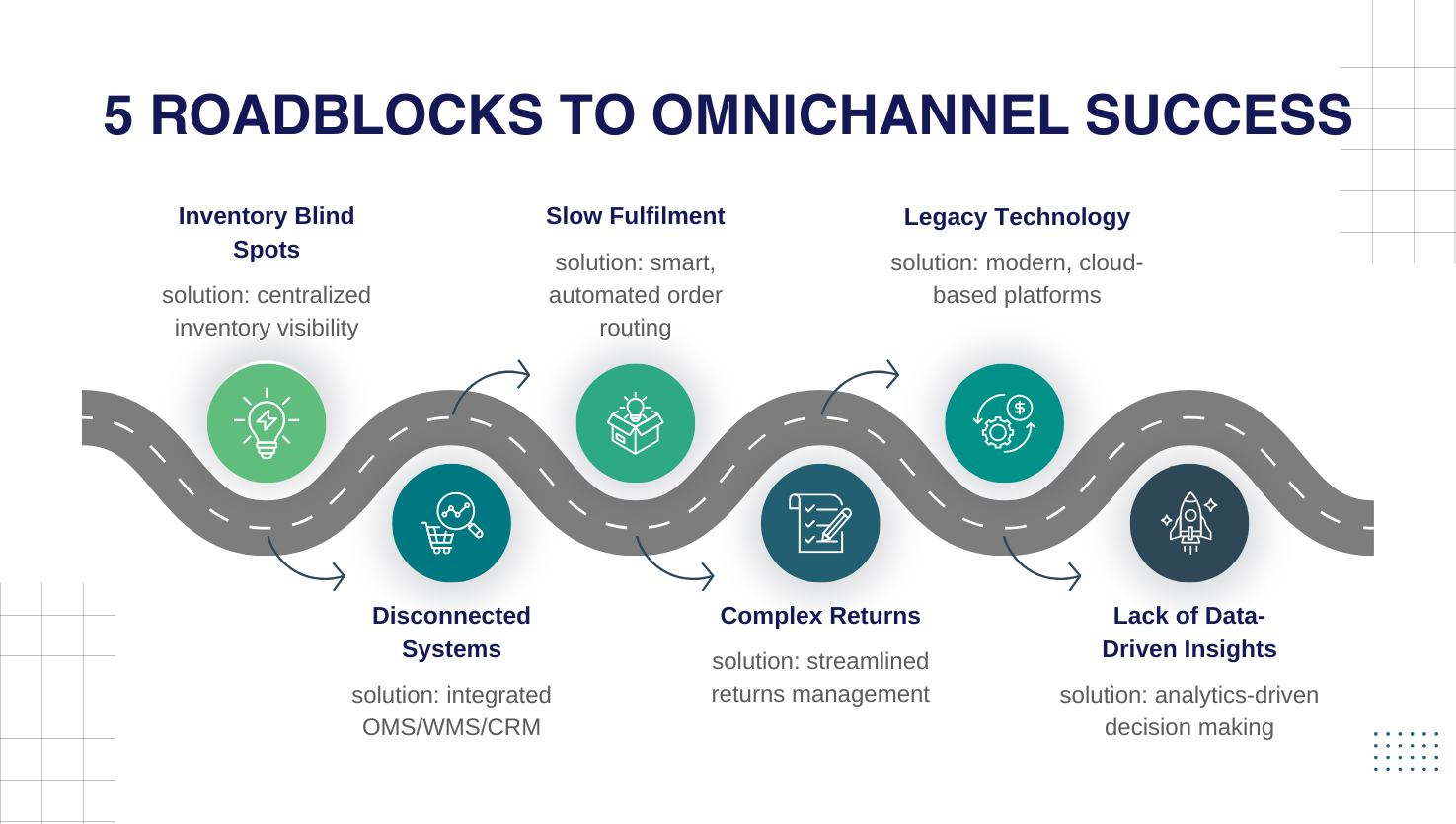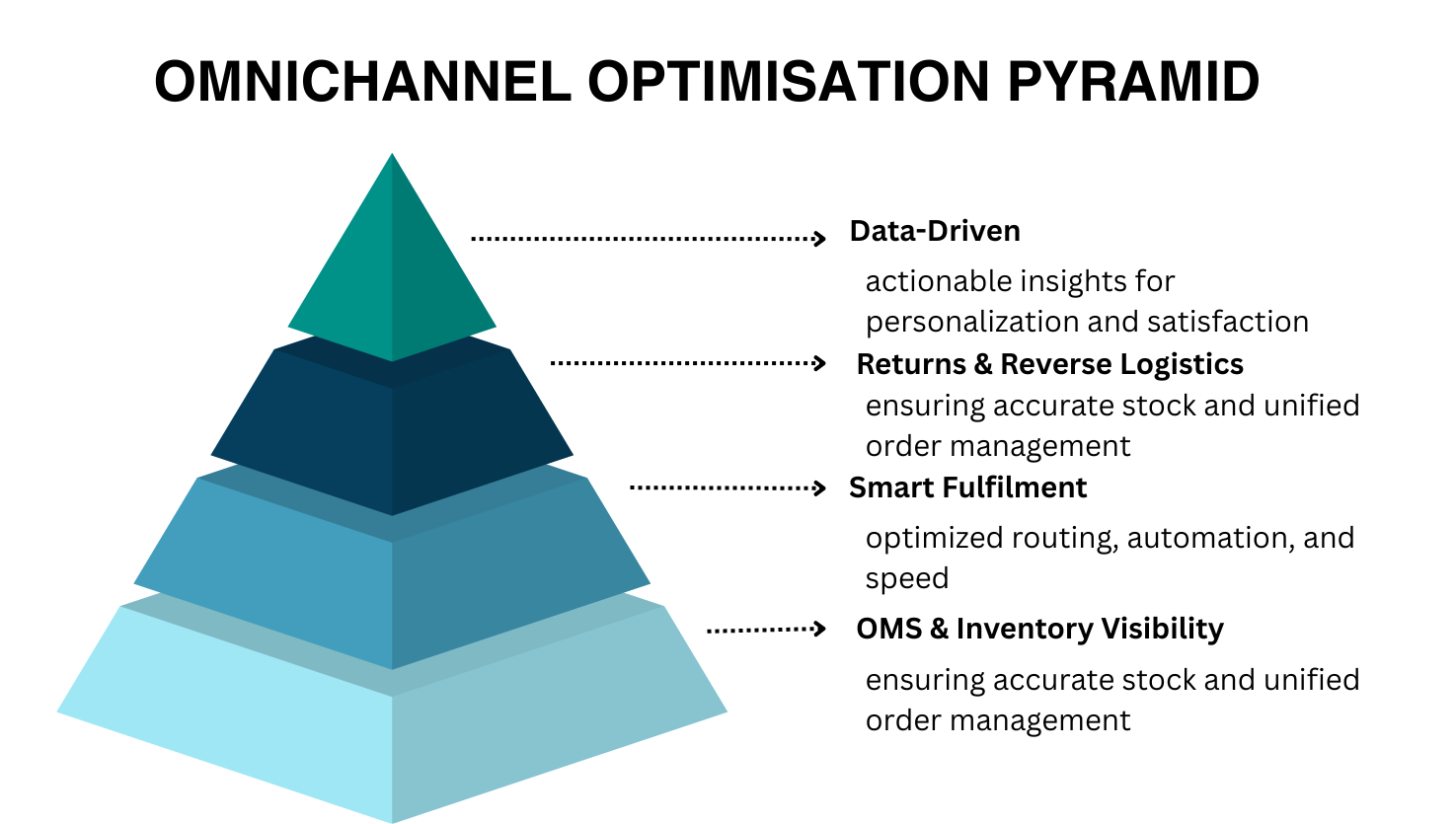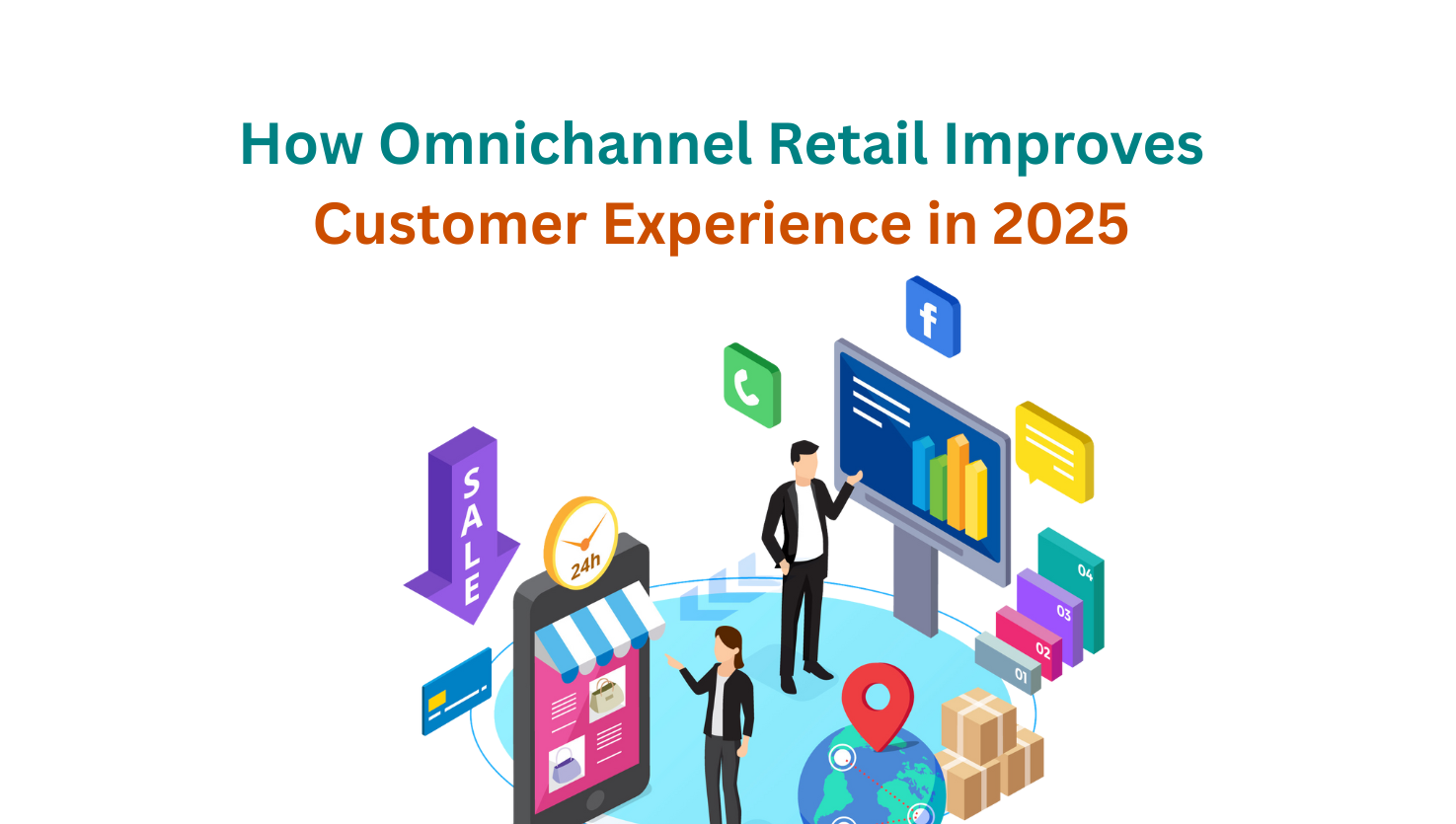Think about the last time you shopped, maybe you scrolled through a brand’s Instagram page, added something to your cart online, and decided to pick it up from a nearby store. Or perhaps you ordered from your phone and returned it later at the store. That effortless switch between channels is what omnichannel retail logistics makes possible.
Simply put, omnichannel retail logistics is the system that connects all the moving parts of retail, from stores and warehouses to online platforms and last-mile delivery, into one unified network. It ensures that inventory, orders, fulfilment, and returns flow seamlessly across every channel. The goal is simple: no matter where or how customers shop, they enjoy the same smooth, connected experience every time.
Today, this isn’t just a nice-to-have, it’s what customers expect. When logistics fall short, even the best customer experience starts to crumble. But when it’s done right, it builds trust, loyalty, and operational efficiency all at once.
In this blog, we’ll explore how omnichannel logistics helps retailers deliver that unified experience, from what defines it and why online – offline integration matters, to the challenges, strategies, and best practices that can help brands thrive in a truly connected retail world.
Why a Unified Omnichannel Customer Experience Depends on Logistics
In today’s retail world, customers don’t shop in a straight line. They scroll through social media, compare prices online, visit physical stores, and expect instant delivery, all in the same journey. Meeting these expectations requires omnichannel logistics that seamlessly connect every touchpoint. It’s not just about having multiple sales channels; it’s about making every interaction feel consistent, effortless, and personal.
Many retailers have stitched together multiple systems that don’t talk to each other, OMS here, WMS there, spreadsheets everywhere. The result? Missed SLAs, delayed updates, and rising costs. eShipz unifies these silos, creating an invisible layer that connects inventory, fulfilment, and delivery into one seamless experience. When logistics and technology work together, the customer journey feels smooth, reliable, and completely customer-centric.
Key Elements of a Unified Omnichannel Experience
1. Unified Databases and Integrated Systems
All inventory, orders, and customer information must live in a central, connected system. With eShipz’s multi-carrier and multi-warehouse integration, retailers gain real-time visibility across every store, warehouse, and fulfilment centre. This prevents overselling, stockouts, and delayed shipments, ensuring customers can shop confidently anywhere, anytime.
2. Consistent Messaging and Branding
Consistency builds trust. eShipz synchronizes product information, pricing, promotions, and tracking updates across all sales channels, online, mobile, and in-store—so every touchpoint tells the same story, creating a reassuring, seamless experience.
3. Flexible Fulfilment Options
Modern shoppers want choice: home delivery, in-store pickup, curbside collection, or locker delivery. eShipz’s Smart Fulfilment Engine automatically selects the best fulfilment option based on inventory location, delivery speed, and cost, ensuring orders reach customers quickly while optimizing operational efficiency.
4. Breaking Down Silos
Retailers often face disconnected systems that slow down operations. eShipz integrates OMS, WMS, CRM, and carrier networks into a single platform, enabling seamless order processing, returns management, and tracking updates. This unified approach ensures orders move smoothly from warehouse to doorstep, and returns are handled consistently.
5. Data-Driven Decisions
Data is the backbone of omnichannel logistics. With eShipz Analytics and Control Tower, retailers can track delivery performance, predict demand, optimize routing, and make informed inventory allocation decisions. The result is proactive operations, reduced costs, and improved customer satisfaction.
The Transformative Impact
- Frictionless Shopping: Customers move seamlessly between online, mobile, and in-store.
- Operational Efficiency: Real-time inventory, smart fulfilment, and integrated returns reduce delays and costs.
- Smarter Decisions: Data-driven insights power predictive planning, faster fulfilment, and better resource allocation.
- Enhanced Loyalty: A reliable, unified experience builds trust and repeat business.
Mastering omnichannel retail logistics isn’t just about efficiency, it’s about shaping how customers feel. By connecting channels, breaking silos, and leveraging eShipz’s features, retailers can create a seamless, memorable shopping experience that drives loyalty, satisfaction, and growth.
Key Challenges in Omnichannel Retail Logistics
Implementing omnichannel retail logistics is no easy feat. While the benefits of a seamless, connected customer experience are clear, retailers face several critical challenges that can make or break success:
1. Real-Time Inventory Visibility
Customers expect that the moment they see a product online or in-store, it’s available. Achieving this requires a system that tracks inventory across every location, warehouses, stores, and fulfilment centres, in real time. Without it, overselling, stockouts, and unhappy customers become inevitable.
2. Intelligent Order Routing and Fulfilment
Not every order should be fulfilled the same way. Retailers must decide which warehouse, store, or fulfilment hub can deliver the fastest, most cost-effective service. Intelligent routing ensures that orders reach customers efficiently, keeping expectations aligned and delivery promises fulfilled.
3. Technology Integration
Seamless omnichannel logistics depends on integrating multiple systems: OMS (Order Management System), ERP (Enterprise Resource Planning), CRM (Customer Relationship Management), and analytics platforms. Disconnected systems create blind spots in inventory, slow down fulfilment, and disrupt the customer experience.
4. Returns Management and Reverse Logistics
Returns are an inevitable part of retail, and customers expect flexibility. A robust omnichannel system enables returns from any channel, online or offline, without creating confusion or extra effort. Poorly handled returns not only frustrate customers but also strain operations and erode trust.
5. Legacy Supply Chain Limitations
Many traditional supply chains were designed for single-channel retail. They lack the flexibility and visibility required for omnichannel complexity. Modernising these networks is essential to support real-time inventory, smart fulfilment, and seamless customer experiences.
Overcoming these challenges is essential for retailers who want to deliver frictionless shopping experiences. When addressed thoughtfully, these obstacles become opportunities to strengthen operational efficiency, customer satisfaction, and brand loyalty.
Optimising Omnichannel Retail Logistics:
In today’s retail landscape, customers don’t just shop, they experience your brand across multiple channels. Delivering a seamless omnichannel experience isn’t just about implementing technology; it requires a thoughtful, connected approach across systems, touchpoints, and operations. By aligning strategy and execution, retailers can transform logistics from a back-end function into a powerful driver of customer satisfaction, loyalty, and growth.

1. Build a Unified Order Management System (OMS)
A robust OMS connects all sales channels, inventory, and fulfilment processes into one central system. Whether an order comes from online, mobile, or in-store, it is tracked and managed efficiently, reducing errors, delays, and customer frustration. This single source of truth forms the backbone of any successful omnichannel strategy.
2. Offer Smart Fulfilment Options
Customers today expect speed and flexibility. Ship-from-store, store pickup, drop-shipping, and locker deliveries allow retailers to balance cost, speed, and inventory efficiency. Providing multiple fulfilment options meets diverse customer preferences while optimizing operational efficiency.
3. Ensure Real-Time Inventory Visibility
Knowing exactly what’s available across stores, warehouses, and fulfilment centers is critical. Real-time inventory visibility prevents stockouts and overselling, enhances customer confidence, and ensures that orders are fulfilled accurately and promptly.
4. Deliver a Customer-Centric Journey
A single view of the customer across all touchpoints enables personalized experiences. From tailored product recommendations to hassle-free returns, every interaction, online, mobile, or in-store, feels thoughtful, seamless, and coordinated.
5. Leverage Data-Driven Decisions
Analytics empower retailers to be proactive rather than reactive. By predicting demand, optimizing routing, and managing allocations, data helps make smarter, faster, and customer-focused decisions that enhance operational efficiency and the shopping experience.
6. Apply the 4 C’s of Omnichannel
- Customer: Understand shopper behavior and preferences.
- Content: Deliver consistent messaging and product information.
- Context: Personalize experiences based on location, device, and history.
- Channel: Ensure every touchpoint, app, web, store, social. works in harmony.
7. Focus on the 4 Pillars of Omnichannel
- Integration: Connect all systems and processes.
- Data: Capture and leverage real-time insights.
- Fulfilment: Optimize delivery, returns, and inventory management.
- Technology: Use robust tools (OMS, WMS, CRM) to orchestrate the experience.
8. Implement Best Practices Across the Organization
- Maintain Consistency: Branding, messaging, and pricing should remain uniform across all channels to build trust.
- Integrate Online and Offline Data: Connect CRM, OMS, ERP, and other systems for a unified view of customers.
- Offer Flexible Fulfilment: Home delivery, in-store pickup, curb side collection, or locker options give customers control and optimize inventory.
- Train Staff Across Channels: Store associates, call center staff, and fulfilment teams should be equipped to handle cross-channel orders seamlessly.
- Monitor Performance Metrics: Track delivery speed, return rates, order accuracy, and customer satisfaction (CSAT/NPS) to continuously improve the experience.

By following these strategic steps and best practices, retailers can elevate logistics from a back-end operation into a core enabler of exceptional customer experiences. The result: a unified, seamless journey that drives loyalty, efficiency, and sustainable growth.
The Future of Omnichannel Retail Logistics
Omnichannel logistics is evolving rapidly. Key future trends include:
- Faster delivery and real-time updates to meet rising customer expectations.
- AI and ML-driven fulfilment and routing for predictive, data-driven operations.
- Agile, networked supply chains that are channel-agnostic.
- Circular logistics, returns, and subscription models as customer expectations shift.
Retailers who embrace these trends will stay ahead in delivering a seamless, consistent experience.
In a Nutshell
In today’s fast-moving retail world, customers expect every interaction to be seamless, whether online, in-store, or anywhere in between. Connecting all touchpoints, streamlining operations, and overcoming logistical challenges isn’t just smart, it’s essential. The payoff? Effortless experiences for your customers, stronger loyalty, and operational efficiency that fuels growth.
Don’t let gaps in your logistics slow you down.
Explore how eShipz can help you unify your retail channels and transform your delivery experience, Contact Us Today.

